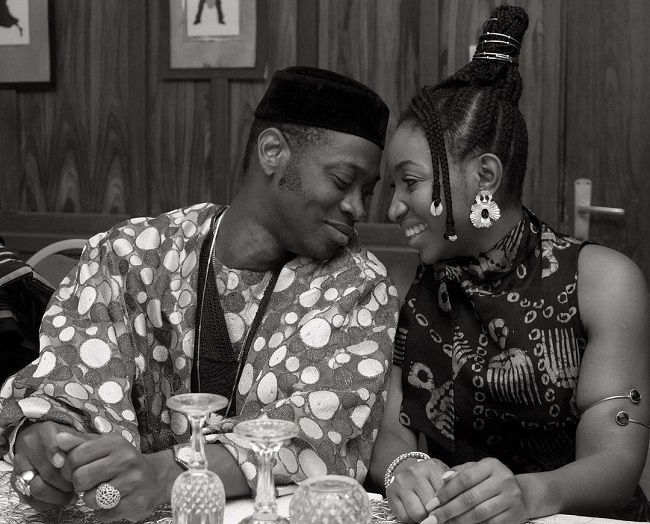Ayinla Omowura, born Waidi Ayinla Yusuf Gbogbolowo in 1933, was an Apala musician from Itoko, Abeokuta. He had many aliases and earned the moniker, Hadji Costly because of his flamboyant dressing in the traditional Yoruba attire, agbada, made of high-quality Swiss lace and gold jewellery. His other aliases include Egunmogaji, Anigilaje and Alujannu Elere.
Ayinla died on May 6, 1980, aged 47.
Ayinla Omowura’s Apala prowess included “command of puns, proverbs innuendos and metaphors. He was a social commentator, a critic as well as a moral instructor. He often served as a mouthpiece for passing on government policies to the masses and was also a messenger of the masses back to the government,” Wikipedia notes.


To recognise this greatness, the movie, “Ayinla”, released June 18, 2021, tells the story of Ayinla Omowura, was directed by star director, Tunde Kelani, and produced by Jadesola Osiberu.
“Ayinla” premiered on June 13, 2021, in Lagos and was released to the theatres on June 18.
The cast includes Lateef Adedimeji who assumed the role of ‘Ayinla’, starring alongside Omowumi Dada, Bimbo Manuel, Ade Laoye, Kunle Afolayan, Bimbo Ademoye and Mr Macaroni, who played the role of ‘Ayinla’s’ manager.


“Ayinla” is Tunde Kelani’s first major film since his 2015 release of “Dazzling Mirage,” and the budget for this feature film is reportedly given as ₦50 million. And, it was set and shot on location in Abeokuta, Ogun.
“Ayinla” grossed ₦70.49 million at the Nigerian box office more than four weeks after its release. As of December 2021, the film had made over ₦91 million, according to data by the Cinema Exhibitors Association of Nigeria (CEAN).
But, the popularity of the movie only peaked when it got to Netflix. On Google Trends, “Ayinla” hovered between 5 and 33 when it was released at the cinemas.


The movie, which streams for 1:58 minutes, was uploaded on Netflix on May 20. The announcement that it was going to be on Netflix increased its popularity. Thanks to a hard-working marketing team.


Its popularity has however since dropped to 59.
Does “Ayinla” live up to expectations?
Because it is Tunde Kelani, you are possibly going into the film with a bias that “Ayinla” will make your day. But, as with many other adaptations, you may be disappointed.
Without a doubt, the movie brings the story of Ayinla Omowura to the eyes and ears of younger Nigerians, who may never have known of his existence – not forgetting the ones who would never read history and the ones who do not understand the elements of good music.
Indeed, the story portrays the main character in the truest manner as with what is obtainable during Omoruwa’s time. Again, his diction is appropriate to the plot and his identity. But, the character struggles with Omowura’s music anytime he performs.
The choice of the cast, the use of the Egba language (in consonance with the location, Abeokuta and Omowura’s origins), the styling (thank the Heavens we did not see the ladies in flowing gowns and flowery blouses), and the set designs are all commendable. But one important part is fundamental – effective storytelling, and that may be missing because we are distracted by apparent omissions and unnecessary scenes – unless we are looking at a limited series.
More than thirty minutes into the film is just a convergence of different scenes which only connect if you knew Ayinla Omoruwa’s story.
For instance, we are being introduced to a supposed Marxist or social activist who does not understand the difference between a news report and an academic work. The journalist does not understand that to write about a popular figure, you have to be immersed in the person’s work.


Like Bimbo Manuel tells her – we are telling the scene, “Jaiye, get out”. That is about five minutes we do not need for a shorter version of Omowura’s whole life story.
We understand the need to portray the role of the media in storytelling, in history, and definitely in Omowura’s story. However, this can begin when the character that represents the leadership at the legendary media house, Iwe Iroyin, calls to ask that they be wholesomely part of ‘Ayinla’s’ tour in the UK.
Next, we go on to ‘Ayinla’s’ spiritual fortification, and you begin to wonder about the significance of those small parts to the big picture.
At some other point, ‘Ayinla’ and an unknown singer meet at the police station for a vague reason. Unless you knew that he had squabbles with other singers like Haruna Ishola, Ayinde Barrister, Fatai Olowonyo, Yesufu Olatunji and Dauda Epo Akara, you are going to rewind to understand what that scene is supposed to tell you.
What if we understood what the fight was about and how it started?
You will struggle with stringing the scenes in “Ayinla”.
Then, how did the doctors and the people who carried ‘Ayinla’s’ body not see the bottle in his head, until at the mortuary? It is reported that that is the story, but we do not want to see a replay of Fashola as Sherlock Holmes.
Read also: Movie review: Is Blood Sisters just another Nollywood hype?
On set location and camera
As cameras have become smaller over time, new technology is constantly being invented to move them in every direction possible. So are camera movements by Directors of Photography becoming better.
Ayinla does not fail in this regard and you will commend the implementation by the people behind the scenes.
Camera movement can add a lot of meaning to the whole film, changing and shaping a viewer’s perspective of a scene. It’s essential to understand how your viewers interpret different types before adding in pans, zooms, tilts, and the like.
For instance, you will observe that the logo of the sponsor of the movie, First Bank, is shown at some point but does not stay, and the camera pans back to the relevant part of the scene.
Also, we do not see the popular bridge in most Nigerian movies or the unnecessary showings of historical places in Abeokuta, but, it is obvious that it was a shot in an old town like Abeokuta and that is enough.
The location affected the look of the entire film, and it set the psychological mood of the story. Even Ayinla’s house is not bigger than the Palace of the Alake of Egbaland.
A comment on some characters
Baiyewu (by Mr Macaroni): was a childhood friend of Ayinla Omowura, and when Ayinla became a famous musician, Baiyewu was his Manager. However, the character was timid and the viewer would not have known they were childhood friends until it was mentioned.
It looked more like a modern-day celebrity and manager relationship, which is usually a mix of the unfriendly, the respected and the slaved.
Ajala (by Kunle Afolayan): owned the event planning company that was to take ‘Ayinla’ to the UK for the Apala tour and was portrayed as a focused entrepreneur. With a cigar in his mouth and in his Mercedes Benz, what you see is a business executive ready to do business.
The character played his part and gives an idea of how comfortable people at that time lived their lives.
Deborah (by Omowunmi Dada) was ‘Ayinla’s’ lover for a short time in the film and maybe we should see more of her, especially since it was reported that she helped Ayinla Omowura become more enlightened; as he was unlettered. The time when she did this is missing in the movie.
She was also supposed to help ‘Ayinla’ become a better person, but what we only see are two people who fell in love and that is it. His temper stayed after he met her, and that is what led to his death.
What does “Ayinla” bring to the table?
Alhaji Ayinla Omowura’s musical career took off when he started with a brand of music called ‘Olalomi’ in the early 1950s; this brand of Apala music was popular among young people in Nigeria and the West Coast, but this brand faded with time.
His career took a new dimension when he joined “EMI” records in 1970 and recorded a single titled ‘Aja to foju d’ekun’.


Ayinla Omoruwa’s music was mostly a comment on politicians. In the song, Eyin Oselu wa (Our Politicians) Omowura advised politicians to focus on development and stop unnecessary arguments.
The prominent singer stood out as a critic and social commentator serving as the people’s mouthpiece and is sometimes compared with Fela Anikulapo Kuti.
Ayinla would use his platform to lament on behalf of the people using puns and proverbs. He also kept the masses informed whenever there was a new government policy. His lyrics often touched on the current affairs of the country at the time.
Apart from social issues, Ayinla used his music to criticise bleaching and promiscuity among women while pushing for a better society.
The movie reopens those conversations from Ayinla Omowura’s point of view and reminds us that the issues that existed during that period have not abated – in fact, they have worsened.
“Ayinla” reexamines the use of music in social change which is mostly a missing factor in contemporary music.
In volume 13, Ayinla urged everyone to offer prayers to God, so that all will be well:
Ile aye den yi lo sopin )2ce
Omo Adamo se n’ roju aye
gbogbo nkan lo ti won bi oju
Garri two naira ko ju teni meji…
( Ayinla Omowura, volume 13:2:1)


Translated thus:
The world is coming to an end (2ce)
Everyone, are you seeing what the world
is turning to, everything has become very costly
two naira garri
is not enough for two people…
Political satire has always been used by a citizenry to express their grievances against political office holders, and Apala music is laden with such political messages that call out politicians for their shenanigans.
The movie reminds us that Ayinla Omowura’s music is highly entertaining with strong, energy-driven rhythms and melodic lines spiced with thought-provoking, proverbial and anecdotal lyrics – enough to draw attention and mobilise people for social change.
Stream or skip?
Tastes differ, and you may just want to have a taste of Ayinla’s life, which is a good idea.


But, you will need to read a biography of Ayinla Omowura to have more than a taste of how influential his music was during his time, such that an album was packaged by Professor Oyetola Oniwide, a University Don who is also the presenter of ‘Orin Apala’ on Family FM, Abeokuta.
For an icon, a movie series is more appropriate. One that singles out each part of his life, and puts them together as a complete story.
Though “Ayinla” is a good introduction to the life of the music icon, we should thank Kelani and Osiberu for bringing Ayinla Omowura to our eyes and ears. Maybe, just maybe, we may begin to understand the essence of music beyond body parts and sexualisation.
*Feature image: Sodas ‘N’ Popcorn Blog






